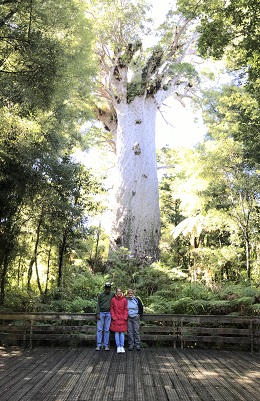 Written by guest blogger Rhonda Carrim
Written by guest blogger Rhonda Carrim
Recently our family visited the Waipoua Forest in the Northland of New Zealand. A must-see attraction in the forest is Tāne Mahuta, New Zealand’s largest known living kauri tree. Kauri, a type of conifer, are massive trees; only California’s Giant Sequoias are larger. Tāne Mahuta stands nearly 170 feet tall, with a trunk girth of more than 45 feet. Kauri also have longevity; Tāne Mahuta’s estimated age is between 1,200–2,000 years old.
Tāne Mahuta is Maori for “Lord of the Forest.” In Maori mythology, Tāne is the son of the sky father and the earth mother who pushed earth and sky apart and then clothed the forest with flora and fauna. In fact, all living creatures of the forest are regarded as children of Tāne Mahuta.[1]
As we stood admiring this massive tree, a young Maori conservationist told us more about Tāne Mahuta in particular and kauri trees in general. A few facts which stood out include the following:
- Mature kauri generally reach heights of 100-130 feet with a diameter between 3-16 feet.
- The kauri root system is fragile because it is so near the surface, only 15-20 feet underground at the most. Kauri rely on the collective weight and intertwining root systems of nearby trees and bushes to keep them from toppling over.
- As a tree grows past the forest canopy, the permanent branches at the top of the tree spread, soaking in the sunlight required for the growth and health of the tree. However, a kauri tree will “self-prune” its canopy so that it will not block the sunlight for the surrounding trees and bushes.
- When a branch breaks off or the tree experiences stress or damage, the tree secretes a gum to counteract the stress or heal the wound. When a permanent branch breaks, the gum heals the wound and another branch may grow from the stub. The gum also helps ward off disease and insects which could harm the tree.
I’m sure you can draw several leadership lessons of your own, but here are a few thoughts I had when learning about Tāne Mahuta and the kauri trees.
Good leaders rely on those around them to remain grounded.
Although a mature kauri is the tallest tree in the forest, it relies on nearby trees and bushes to help it stand, particularly in high winds. As the tallest tree, it receives the full force of the wind. Without the support of the surrounding trees and bushes, even a moderate wind could fell a mighty kauri!
Who in your organization or in your life helps keep you grounded? As a leader, you are more likely to be buffeted by various winds: criticism, cynicism, busy-ness, fatigue, stress, and others. Without an adequate supporting network, even the strongest leader is susceptible to a crashing – and crushing – fall!
Smart leaders do not “block the light” of those serving under them.
The kauri “self-prunes” in order to ensure that the trees and plants beneath its canopy have sufficient light and nutrients for healthy growth. After all, the kauri is dependent upon those very plants to help keep it grounded and standing!
Smart leaders must recognize their interdependence upon others. A particularly gifted or charismatic leader may be able to accomplish a great deal. However, even the most gifted leaders cannot carry an organization to sustained excellence completely on their own.
Leaders who feel threatened by others within their organization are more likely to make decisions aimed at maintaining their own power and authority rather than on what is best for the good of the organization. They are also more likely to squelch creativity and ingenuity. In short, they overshadow and drain the life from others.
Wise leaders recognize that people possess different skills and talents and will seek to bring out the best in others. Additionally, wise leaders will nurture other leaders within the organization. They seek to ensure sufficient resources are available to those serving under them, whether this means material resources, adequate training and supervision, or encouragement. Smart leaders seek to provide optimal conditions for the healthy growth and well-being of those they lead.
Healthy leaders have internal reserves for replenishing well-being in times of stress or hurt.
Kauri gum, the trees’ “internal reserves,” provides protection and healing. Effectiveness and longevity in leadership requires holistic self-care: emotional, physical, spiritual, intellectual, relational. Only the delusional think they can lead without stress, pain or wounds.
However, too often normal stress is magnified because of poor eating habits, lack of physical activity, or inadequate attention to one’s own spiritual well-being. Words of criticism (wounds) may lead to depression or fester into bitterness and resentment if our sense of worth is not firmly grounded in our identity in Christ and what God has called us to be and to do.
Holistic self-care enables leaders to be more resilient in the face of storms, stress, and wounds that invariable come their way.
Do you have people around you who help keep you grounded, whether life is calm or stormy?
Are you allowing and facilitating the flourishing of others within your organization?
Do you practice appropriate self-care to build internal reserves that will facilitate protection and healing?
If you would like help in achieving your goals as a leader or in any area of your life, call us at 208-880-0307 or email us at errol@errolcarrim.com to schedule a complimentary coaching session. To read other posts, visit Christ-Centered Life Coaching.
 Written by guest blogger, the Rev. Dr. Rhonda L. Carrim, associate professor of Practical Theology at Northwest Nazarene University. Previously, she taught and pastored in Trinidad and England. She and husband Errol are passionate about helping Christian leaders thrive in life and ministry.
Written by guest blogger, the Rev. Dr. Rhonda L. Carrim, associate professor of Practical Theology at Northwest Nazarene University. Previously, she taught and pastored in Trinidad and England. She and husband Errol are passionate about helping Christian leaders thrive in life and ministry.
[1] https://www.doc.govt.nz/parks-and-recreation/places-to-go/northland/places/waipoua-forest/things-to-do/tane-mahuta-walk/. 11 May 2018.
